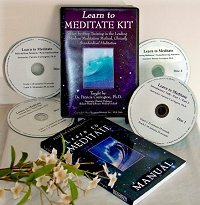The Mystery of the Mantra
What is the Impact of Sound During Meditation
Impact of Sound on Emotions
Patricia Carrington, Ph.D.
Author of “The Book of Meditation” and creator of The Learn to Meditate Kit
Obviously certain sounds have different effects from other ones. We respond differently to a Mozart sonata than to a rock concert. Some proper names seem soft and pleasing to us; others seem harsh and unpleasant. While our responses may be partly due to past experiences (our personal associations with different sounds) there are good reasons to suppose that we also have innate responses to certain sounds.
Most people react with comfort and relaxation to the sound of a bubbling brook, or to gentle rainfall on a roof; and tend to respond with discomfort and tension to the sound of a trip hammer (even at a distance where its loudness is not a factor), or the sound of chalk scraped against a blackboard. Even subhuman organisms respond differently to different sounds. The use of certain types of music to stimulate the growth of plants, for example, is no longer viewed as merely a pleasant folk tale. Certain colleges of agriculture are now teaching their students to use music to foster the growth of healthy crops based on the results of experiments in this area.1
Actually the concept that specific mantras have specific effects does not presuppose any mysterious process. Since various sounds elicit different responses, it is logical to suppose that repeating one particular kind of sound to ourselves might have a somewhat different effect on us than repeating another one.
I have mentioned the modern Westernized technique of meditation developed by Dr Herbert Benson, the Harvard cardiologist (see Chapter 2). Consider Benson’s choice of the sound which he asks his trainees to repeat during their meditation: the word ‘one’. While he chose this word because it was ‘euphonious’ and did not have ‘sharp’ sounds (he considered the next number up the scale with such a pleasing quality to be ‘nine’), the word is interestingly close to the Sanskrit mantra ‘Om’, which is traditionally considered to have powerful effects. Most of the other leading Sanskrit mantras also end in a resonant nasal sound – in ‘n’, ‘m’, ‘ing’ sounds that tend to reverberate within the head even when we are merely thinking them.
Some research suggests, in fact, that we may be producing movements in the small muscles of the middle ear when we ‘think’ in sound. When Dr Howard Roffwarg and his associates at Montefiore Hospital in New York City studied the middle ear muscles of sleeping subjects, they found that activity in these muscles tended to occur during dream sequences involving sounds, and not to occur when there had been no imagined experience of sound in a subject’s dream.2 If muscles within our auditory apparatus can respond to an imagined sound in a dream just as they do to ‘real’ sound, then the emotional impact of imagined sounds may be similar to that of real ones.
If you’d like to conduct an experiment of your own to find out the effects of using different sounds as ‘mantras,’ you can try Benson’s method of meditation using two different words. To do this, sit comfortably in a quiet room, close your eyes, and begin mentally repeating the sound ‘one’ to yourself on every out-breath. The sequence goes like this: breathe in – breathe out ‘one’ . . . breathe in – breathe out ‘one’ . . . Keep repeating this sequence in your mind for about two minutes and then substitute mental repetition of the word ‘two’ on each out-breath.
You will probably find a difference in your responses to the two sounds, how great a one depending upon your sensitivity to specific sounds and your own preferences. If you intend to carry out this experiment, it’s probably a good idea to do it before reading further, however. The following discussion might influence your observations.
In an informal test of these two sounds, many people have reported that thinking ‘two’ involves a slight, almost imperceptible twist of the tongue which has been trained to reach toward the front of the hard palate for the ‘t’ sound. Thinking ‘two’ also made some people’s stomach muscles tense slightly and it was often described as being somewhat sharp and abrupt in sound as opposed to being gradual, lingering and resonant (the qualities most often attributed to ‘one’). The sound ‘two’ was more often felt as being light, superficial and at times even somewhat annoying, while many people felt the sound ‘one’ to be calm and steadying, giving them a sense of being ‘pulled together’ or centered. Those who found ‘two’ an abrupt sound sometimes found themselves becoming restless rather than quieted by their meditation.
Despite this, in trying this experiment some of you may have responded with greater calm to the word ‘two’. What calms one person may excite another, and vice versa – another reason why meditation devices should be selected with the aim of suiting them to the individual.
You may also have noticed associations with these two words affecting your reactions. Mental associations with the word ‘one’ are quite significant for English-speaking people. ‘One’ implies unity and completion. It is the word for ‘singular’ and also the word for ‘all’, the phrase ‘one world’ meaning not so much a single world as a unified one. The word ‘one’ seems in fact to imply both individuality and totality at once, a concept which may be seen by some as having metaphysical implications. Repeating the word ‘one’ can affect the meditator, then, not only because of its sound but also because it evokes the thought of being ‘pulled together’ into one unified being. ‘Two’, on the other hand, has no such connotations for most people. In fact its associations in the English language are rather meager, although for any particular individual it may hold very meaningful personal associations.
Our mental associations with a word can even have an effect on our reaction to it if the sound is in an unfamiliar language such as Sanskrit. Certain traditional mantras, for example (depending upon how they are pronounced), sound like two short English words put together, and some meditators (myself included) will visualize these English words when they repeat such a mantra mentally. Such responses are of course likely to fade after a while and many meditators indicate that their mantras recede in their minds into a vague, pulsating beat rather than being identifiable as a word when they are having a particularly deep and restful meditation. On our meditation questionnaire, 45 percent of the CSM and TM meditators reported that they actually ‘hear’ the mantra as a word only ‘occasionally or never’.
1. D. Retallack, The Sound of Music and Plants (Santa Monica, Calif.: De Vorss, 1973); P. Weinberger and M. Measures, as quoted in P. Tomkins and C. Bird, The Secret Life of Plants (New York: Avon, 1974), p. 167.Ibid, p. 241.
2. H. Roffwarg, J. Herman and S. Lamstein, ‘The Middle Ear Muscles: Predictability of Their Phasic Activity in REM Sleep from Dream Materials’ (paper presented before the Association for the Psycho physiological Study of Sleep, Edinburgh, 1975).N. Kleitman, Sleep and Wakefulness (Chicago: University of Chicago Press, 1963), pp. 329–38.


